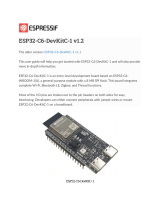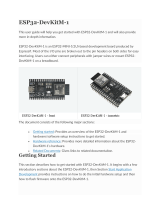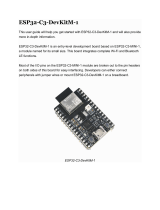
1 Overview
Table 2 – cont’d from previous page
Name No. Type Function2
IO32 8 I/O GPIO32, XTAL_32K_P (32.768 kHz crystal oscillator input), ADC1_CH4,
TOUCH9, RTC_GPIO9
IO33 9 I/O GPIO33, XTAL_32K_N (32.768 kHz crystal oscillator output),
ADC1_CH5, TOUCH8, RTC_GPIO8
NC 10 — —
IO26 11 I/O GPIO26, DAC_2, ADC2_CH9, RTC_GPIO7, EMAC_RXD1
IO27 12 I/O GPIO27, ADC2_CH7, TOUCH7, RTC_GPIO17, EMAC_RX_DV
IO14 13 I/O GPIO14, ADC2_CH6, TOUCH6, RTC_GPIO16, MTMS, HSPICLK,
HS2_CLK, SD_CLK, EMAC_TXD2
IO12 14 I/O GPIO12, ADC2_CH5, TOUCH5, RTC_GPIO15, MTDI, HSPIQ,
HS2_DATA2, SD_DATA2, EMAC_TXD3
NC 15 — —
GND 16 P Ground
IO13 17 I/O GPIO13, ADC2_CH4, TOUCH4, RTC_GPIO14, MTCK, HSPID,
HS2_DATA3, SD_DATA3, EMAC_RX_ER
NC 18 — —
NC 19 — —
NC 20 — —
NC 21 — —
NC 22 — —
NC 23 — —
IO15 24 I/O GPIO15, ADC2_CH3, TOUCH3, MTDO, HSPICS0, RTC_GPIO13,
HS2_CMD, SD_CMD, EMAC_RXD3
NC 25 — —
NC 26 — —
IO0 27 I/O GPIO0, ADC2_CH1, TOUCH1, RTC_GPIO11, CLK_OUT1,
EMAC_TX_CLK
IO4 28 I/O GPIO4, ADC2_CH0, TOUCH0, RTC_GPIO10, HSPIHD, HS2_DATA1,
SD_DATA1, EMAC_TX_ER
IO16 29 I/O GPIO16, HS1_DATA4, U2RXD, EMAC_CLK_OUT
IO17 30 I/O GPIO17, HS1_DATA5, U2TXD, EMAC_CLK_OUT_180
IO5 31 I/O GPIO5, VSPICS0, HS1_DATA6, EMAC_RX_CLK
IO18 32 I/O GPIO18, VSPICLK, HS1_DATA7
IO19 33 I/O GPIO19, VSPIQ, U0CTS, EMAC_TXD0
NC 34 — —
IO21 35 I/O GPIO21, VSPIHD, EMAC_TX_EN
U0RXD 36 I/O GPIO3, U0RXD, CLK_OUT2
U0TXD 37 I/O GPIO1, U0TXD, CLK_OUT3, EMAC_RXD2
IO22 38 I/O GPIO22, VSPIWP, U0RTS, EMAC_TXD1
IO23 39 I/O GPIO23, VSPID, HS1_STROBE
GND 40 P Ground
NC 341 — —
Cont’d on next page
Espressif Systems 6 ESP32-WROOM-DA User Manual v0.5























